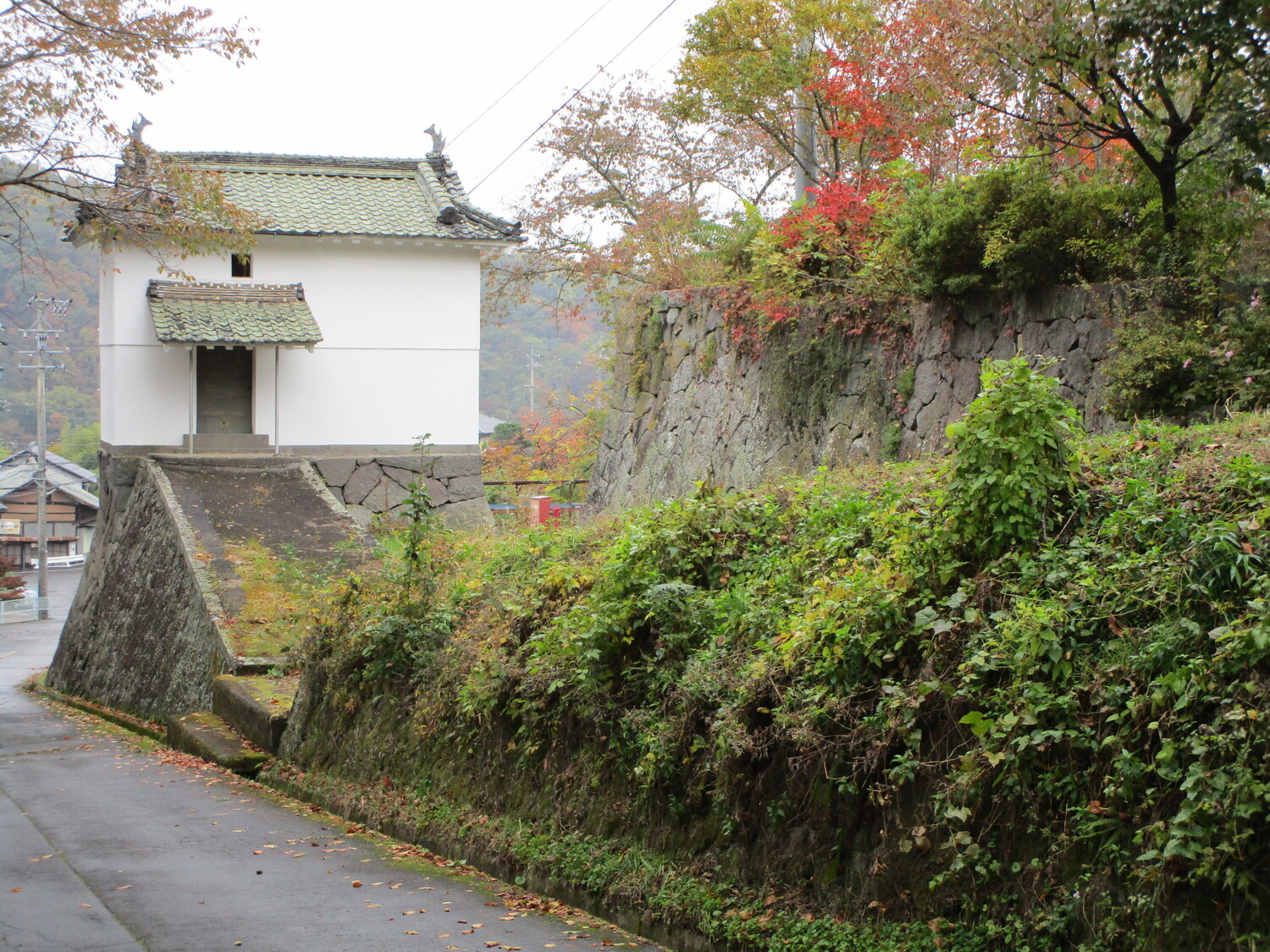Yazawa Jin'ya: Difference between revisions
No edit summary |
No edit summary |
||
| Line 14: | Line 14: | ||
|City=Ueda | |City=Ueda | ||
|Prefecture=Nagano Prefecture | |Prefecture=Nagano Prefecture | ||
|Notes=This site of an Edo period jin'ya or daikansho, a fortified administrative compound used to govern smaller territorial holdings, was formerly the kyokan (residential annex) attached to [[Yazawa Castle]]. I was impressed by the ishigaki (stone-piled ramparts). These beautiful stone walls are the remains of the jin'ya. One platform of piled stone looks like it could've served as a turret foundation. Atop is a storehouse structure which has been "castellated" and has shachihoko (鯱) on the roof. I'm not sure this qualifies as a reconstruction but it looks great. | |Notes=This site of an Edo period jin'ya or daikansho, a fortified administrative compound used to govern smaller territorial holdings, was formerly the kyokan (residential annex) attached to [[Yazawa Castle (Sanada)]]. I was impressed by the ishigaki (stone-piled ramparts). These beautiful stone walls are the remains of the jin'ya. One platform of piled stone looks like it could've served as a turret foundation. Atop is a storehouse structure which has been "castellated" and has shachihoko (鯱) on the roof. I'm not sure this qualifies as a reconstruction but it looks great. | ||
A gate remains from the time of the jin'ya, now on private property. | A gate remains from the time of the jin'ya, now on private property. | ||
|History=In 1622 Sengoku Tadamasa was relocated from Komorojō to Uedajō. His territory included this area, which in 1669 Sengoku Masākira built a jin'ya here to administer. The jin'ya was built upon the former kyokan (residence hall) area of [[Yazawa Castle]]. This "sub-domain" was valued at 2,000 koku, later increased to 2,700 koku, and contained the villages of Yazawa, Shimosato, Akasaka, Urushido, Iwashimizu, Koida, Mori and part of Hayashino-gō (gō = township / collection of villages). This is a fertile area located to the east of the Kamikawa River. In 1706 Sengoku Clan was relocated to Izushijō, but the branch at the Sengoku-yakata remained in place and governed until the Meiji Restoration. | |History=In 1622 Sengoku Tadamasa was relocated from Komorojō to Uedajō. His territory included this area, which in 1669 Sengoku Masākira built a jin'ya here to administer. The jin'ya was built upon the former kyokan (residence hall) area of [[Yazawa Castle (Sanada)]]. This "sub-domain" was valued at 2,000 koku, later increased to 2,700 koku, and contained the villages of Yazawa, Shimosato, Akasaka, Urushido, Iwashimizu, Koida, Mori and part of Hayashino-gō (gō = township / collection of villages). This is a fertile area located to the east of the Kamikawa River. In 1706 Sengoku Clan was relocated to Izushijō, but the branch at the Sengoku-yakata remained in place and governed until the Meiji Restoration. | ||
|Year Visited=Viewer Contributed | |Year Visited=Viewer Contributed | ||
|AddedJcastle=2020 | |AddedJcastle=2020 | ||
Revision as of 12:39, 7 July 2025
This site of an Edo period jin'ya or daikansho, a fortified administrative compound used to govern smaller territorial holdings, was formerly the kyokan (residential annex) attached to Yazawa Castle (Sanada). I was impressed by the ishigaki (stone-piled ramparts). These beautiful stone walls are
History
In 1622 Sengoku Tadamasa was relocated from Komorojō to Uedajō. His territory included this area, which in 1669 Sengoku Masākira built a jin'ya here to administer. The jin'ya was built upon the former kyokan (residence hall) area of Yazawa Castle (Sanada). This "sub-domain" was valued at 2,000 koku, later increased to 2,700 koku, and contained the villages of Yazawa, Shimosato, Akasaka, Urushido, Iwashimizu, Koida, Mori and part of Hayashino-gō (gō = township / collection of villages). This is a fertile area located to the east of the Kamikawa River. In 1706 Sengoku Clan was relocated to Izushijō, but the branch at the Sengoku-yakata remained in place and governed until the Meiji Restoration.
Field Notes
This site of an Edo period jin'ya or daikansho, a fortified administrative compound used to govern smaller territorial holdings, was formerly the kyokan (residential annex) attached to Yazawa Castle (Sanada). I was impressed by the ishigaki (stone-piled ramparts). These beautiful stone walls are the remains of the jin'ya. One platform of piled stone looks like it could've served as a turret foundation. Atop is a storehouse structure which has been "castellated" and has shachihoko (鯱) on the roof. I'm not sure this qualifies as a reconstruction but it looks great.
A gate remains from the time of the jin'ya, now on private property.
| Castle Profile | |
|---|---|
| English Name | Yazawa-jin'ya |
| Japanese Name | 矢沢陣屋 |
| Alternate Names | Sengoku-yakata (仙石館); Sengoku-daikansho; Sengoku-jin'ya |
| Founder | Sengoku Masākira |
| Year Founded | 1669 |
| Castle Type | Flatland |
| Castle Condition | No main keep but other buildings |
| Historical Period | Edo Period |
| Features | gates, stone walls |
| Visitor Information | |
| Access | Ueda Station on the Shinano Railway; Sugadaira Bus from Ueda Station No.3 Bus Stop |
| Hours | Free; 24/7 |
| Time Required | 20 minutes |
| Location | Ueda, Nagano Prefecture |
| Coordinates | 36.41332, 138.30825 |
|
|
|
| Admin | |
| Added to Jcastle | 2020 |
| Contributor | ART |
| Admin Year Visited | Viewer Contributed |









